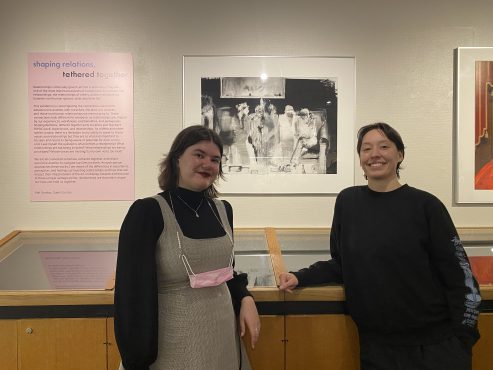The new exhibition explores relationships and togetherness

Photo by Manmitha Deepthi.
When you walk into the McPherson Library, your first thought would rarely be about the art that’s displayed beneath it. However, tucked in the lower level is the Legacy Maltwood Gallery, a space dedicated to artists and their works.
On Nov. 25 the McPherson Library held an opening reception for Shaping Relations, Tethered Together, a new collection of art housed in the Legacy Maltwood Gallery that explores relationships and togetherness.
The event celebrated the exhibition by emerging Edmontonian curator Mel Granley. They are Metis on their mom’s side and a fourth generation Ukrainian settler on their dad’s side. The UVic alumni, now works as a guest curator at the Art Gallery of Greater Victoria.
The event began with Granley reading their curatorial statement. They spoke about how relationships hold an important place in every individual’s life. Shaping Relations, Tethered Together aims to explore this by highlighting BIPOC work, experiences, and relationships.
The exhibition was originally curated for the First People’s House in 2019, however it was delayed until early 2020 and then again due to the pandemic. Three years later, Granley was finally able to see their first show open.
A lot of the art in the exhibition is from the Legacies collection which belongs to the university. The collection includes a variety of mediums and is interdisciplinary in nature. The works range from ceramics, a video piece, and charcoal work to prints, posters, and a magazine.
Rain Cabana-Boucher, whose art is included in the exhibition, also spoke at the event. Cabana-Boucher is a Michif and British artist from Saskatoon and a recent recipient of the Takao Tanabe Prize for emerging British Columbian painters.
Cabana-Boucher’s piece French Exit was made in April 2021. The charcoal piece is about losing community spaces during the pandemic. The work was inspired by one of many parties that Cabana-Boucher attended at a friend’s apartment, where a lot of her friends during university met and interacted. These were queer parties where everyone knew each other and created a safe space. In the piece, Cabana-Boucher wanted to convey the longing she felt for those places and the feeling of isolation that queer people and everyone experienced during the beginning of the pandemic.
Granley and Cabana-Boucher also spoke about the relationship between an artist and a curator and the possibility for a power imbalance between them. The curator is an arbitrator of whose art is shown, yet their relationship is mutually beneficial. Maintaining relationships with artists is essential for curators to showcase art to their community. As well, working together to apply for grants and supporting each other has helped both Granley and Cabana-Boucher to grow in their own careers as curator and artist respectively.
Before the reception came to an end, Granley invited the crowd to ask questions. One attendee asked, “When you were looking through the collection, what were you looking for? What was attracting you to different pieces?”
“I was looking for what I can see and perceive as relationships,” Granley responded. “The show is filtered through my bias of what a relationship is.” They explained that with around 20,000 pieces in the Legacy database, finding BIPOC artists to feature in the collection was a challenge. “[They] have a lot of colonial remnants in them so it is difficult to unravel all the layers of the museum,” Granley said. They tried to not only find relationships but celebrate BIPOC relationships in a non-voyeuristic way. As a result, many BIPOC works were included without labels. Granley felt it was important to avoid imposing their voice on the work, since they can’t speak to where the artists are coming from or why they made the work.
Granley also talked about an upcoming exhibition called Symbiosis that they are working on at the Art Gallery of Greater Victoria. The collection is all about mushrooms and will open in late March of 2023.
Cabana-Boucher also has a new show in the works for next year as part of her residency at the Polygon Gallery in North Vancouver. She is also an artist in residence at the Contemporary Art Gallery of Vancouver which is a research-based residency for which she is working on a podcast.







